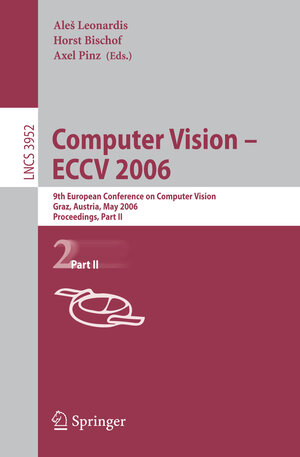
×
![Buchcover ISBN 9783540338345]()
Computer Vision -- ECCV 2006
9th European Conference on Computer Vision, Graz, Austria, May 7-13, 2006, Proceedings, Part II
herausgegeben von Aleš Leonardis, Horst Bischof und Axel PinzInhaltsverzeichnis
- Energy Minimization.
- Comparison of Energy Minimization Algorithms for Highly Connected Graphs.
- A Comparative Study of Energy Minimization Methods for Markov Random Fields.
- Measuring Uncertainty in Graph Cut Solutions – Efficiently Computing Min-marginal Energies Using Dynamic Graph Cuts.
- Tracking and Motion.
- Tracking Dynamic Near-Regular Texture Under Occlusion and Rapid Movements.
- Simultaneous Object Pose and Velocity Computation Using a Single View from a Rolling Shutter Camera.
- A Theory of Multiple Orientation Estimation.
- Poster Session II.
- Resolution-Aware Fitting of Active Appearance Models to Low Resolution Images.
- High Accuracy Optical Flow Serves 3-D Pose Tracking: Exploiting Contour and Flow Based Constraints.
- Enhancing the Point Feature Tracker by Adaptive Modelling of the Feature Support.
- Tracking Objects Across Cameras by Incrementally Learning Inter-camera Colour Calibration and Patterns of Activity.
- Monocular Tracking of 3D Human Motion with a Coordinated Mixture of Factor Analyzers.
- Multiview Geometry and 3D Reconstruction.
- Balanced Exploration and Exploitation Model Search for Efficient Epipolar Geometry Estimation.
- Shape-from-Silhouette with Two Mirrors and an Uncalibrated Camera.
- Robust and Efficient Photo-Consistency Estimation for Volumetric 3D Reconstruction.
- An Affine Invariant of Parallelograms and Its Application to Camera Calibration and 3D Reconstruction.
- Nonrigid Shape and Motion from Multiple Perspective Views.
- 3D Surface Reconstruction Using Graph Cuts with Surface Constraints.
- Statistical Models and Visual Learning.
- Trace Quotient Problems Revisited.
- Learning Nonlinear Manifolds from Time Series.
- Accelerated Convergence Using Dynamic Mean Shift.
- Efficient Belief Propagation with Learned Higher-Order Markov Random Fields.
- Non Linear Temporal Textures Synthesis: A Monte Carlo Approach.
- Low-Level Vision, Image Features.
- Curvature-Preserving Regularization of Multi-valued Images Using PDE’s.
- Higher Order Image Pyramids.
- Image Specific Feature Similarities.
- Coloring Local Feature Extraction.
- Defocus Inpainting.
- Viewpoint Induced Deformation Statistics and the Design of Viewpoint Invariant Features: Singularities and Occlusions.
- Face/Gesture/Action Detection and Recognition.
- Spatio-temporal Embedding for Statistical Face Recognition from Video.
- Super-Resolution of 3D Face.
- Estimating Gaze Direction from Low-Resolution Faces in Video.
- Learning Effective Intrinsic Features to Boost 3D-Based Face Recognition.
- Human Detection Using Oriented Histograms of Flow and Appearance.
- Cyclostationary Processes on Shape Spaces for Gait-Based Recognition.
- Segmentation and Grouping.
- Multiclass Image Labeling with Semidefinite Programming.
- Automatic Image Segmentation by Positioning a Seed.
- Patch-Based Texture Edges and Segmentation.
- Unsupervised Texture Segmentation with Nonparametric Neighborhood Statistics.
- Detecting Symmetry and Symmetric Constellations of Features.
- Discovering Texture Regularity as a Higher-Order Correspondence Problem.
- Object Recognition, Retrieval and Indexing.
- Exploiting Model Similarity for Indexing and Matching to a Large Model Database.
- Shift-Invariant Dynamic Texture Recognition.
- Modeling 3D Objects from Stereo Views and Recognizing Them in Photographs.
- A Boundary-Fragment-Model for Object Detection.
- Region Covariance: A Fast Descriptor for Detection and Classification.
- Segmentation.
- Affine-Invariant Multi-reference Shape Priors for Active Contours.
- Figure/Ground Assignment in Natural Images.
- Background Cut.
- PoseCut: Simultaneous Segmentation and 3D Pose Estimation of Humans Using Dynamic Graph-Cuts.



